WORK PACKAGE 1 - Project Coordination & Management
Current progress
Work package 1 is focused on the efficient management of the GoGreen project. In order to successfully manage the project consortium, WP1 has implemented the following:
- Successful governance and communication strategies. These strategies not only ensured the efficient communication within all work packages and the European Commission, they also ensured the effective management of the project.
- The minimization of environmental impact; the project has adopted specific strategies to reduce travel and its environmental footprint, like the online six-monthly Consortium Meetings, sample sharing and the clustering of meetings.
- Active collaboration across all levels, which includes all PhD students and PostDocs, who have fostered a productive and inclusive research environment.
- The Data Management of the whole project, WP1 ensured a safe online working environment where all partners can work collaboratively. The GoGreen Data Management Plan makes sure that the consortium is working according to the latest GDPR and privacy regulations. The Data Management Plan also aims to make the research data Findable, Accessible, Interoperable, and Reuseable (FAIR).
- The risk management and quality control throughout the project, which includes the monitoring the quality and timely delivery of reports and deliverables and maintaining internal quality assurance and risk management procedures.
- Making sure that possible legal and ethical issues are appropriately dealt with.
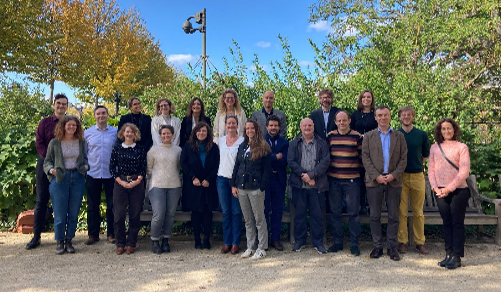
Figure 1. The GoGreen consortium at the Kick-off meeting in Amsterdam, 5-7 October 2022.
The establishment of the International Advisory Board (IAB) was also one of the activities that WP1 carried out. The IAB consists of five experts in green and sustainable activities, to maximize the project's impact. The IAB members are:
- Ms. Maggi Loubser, Senior Lecturer and Coordinator, Tangible Heritage Conservation Programme (South Africa);
- Em. Prof. Norman H. Tennent, Visiting Conservation Scientist, University of Texas, Dallas, Emeritus Professor, Conservation Science, University of Amsterdam;
- Dr. Jitte Flapper, R&D Manager, Expertise Center Advanced Technologies, AkzoNobel Paints & Coatings;
- Dr. Matthew Eckelman, Associate Professor, Department of Civil & Environmental Engineering, Northeastern University, Adjust Associate Professor, Yale School of Public Health Associate Editor, Environmental Science & Technology;
- Dr. Bart Ankersmit, Senior Researcher, Cultural Heritage Laboratory, Cultural Heritage Agency of the Netherlands.
With the established management infrastructure, WP1 will continue ensuring the efficient coordination and integration of all work packages within the project. Besides the efficient management and coordination of the project, WP1 continues to maintain proactive handling of any risks and contingencies that might arise. The same applies for any legal and ethical issues, WP1 will continue to ensure that these are appropriately dealt with.
WORK PACKAGE 2 - Green Preventive Conservation
Current progress
This work package focusses on helping conservators decide whether air conditioning is needed for the collections they are responsible for. There are four main strands;
Understanding the needs of objects made from some of the materials studies in the project; glass, iron, paintings, stone, wood and leather.
- For chemical degradation, small pieces of glass and steel are being exposed to environments in twelve heritage institutions. The atmosphere at each location is being measured for relative humidity, pollutant gasses, particles, and temperature. The degradation of the pieces will be analysed with a variety of scientific equipment after three years.
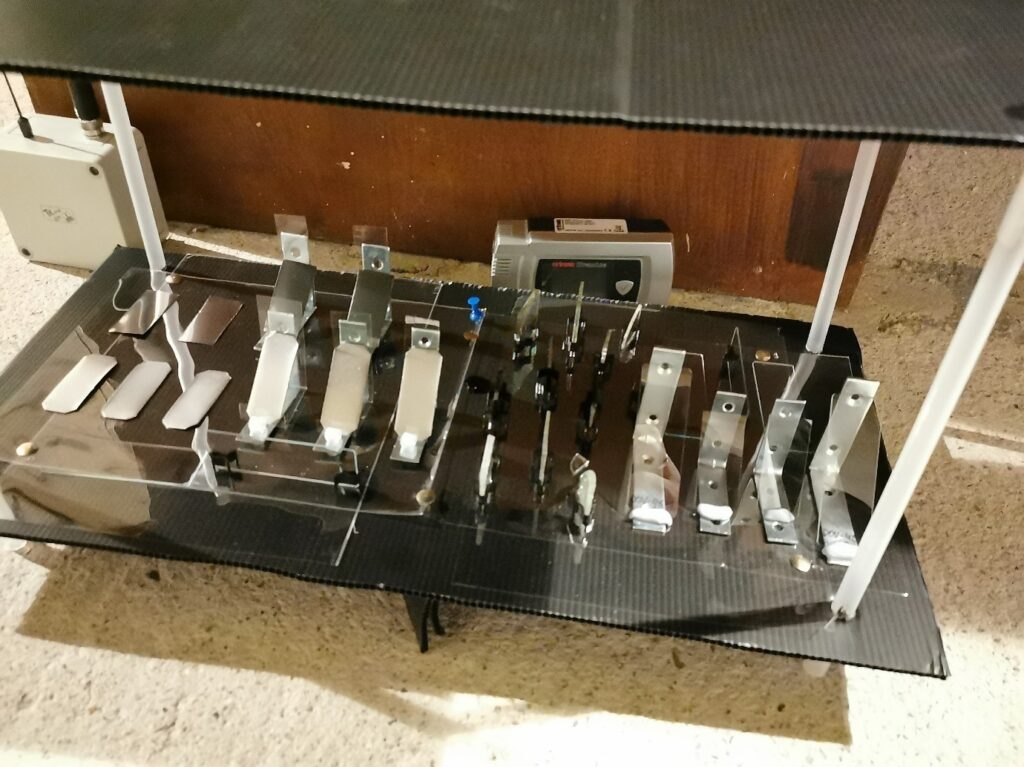
Figure 2. Pieces of glass being exposed.
- For physical deterioration, objects are being monitored. The acoustic emission techniques uses a small sensor placed on the object to detect high frequency sound. This occurs when miniscule cracks occur in the material (years or decades before damage can be observed).

Figure 3. Royal Castle Wawel St. Sebastian wooden statue with acoustic emission sensor.
- Within types of objects, individual objects can react much more quickly or slowly. If these can be identified, then those objects can be protected in climatised enclosures. Different scientific analyses are being investigated to see if they can provide this information.

Figure 4. Near infra-red spectroscopy of glass.
- A collaborative model for holistic green thinking an communication is being developed through co-design approaches with interventive and preventive conservation practitioner from around Europe. Drawing on analysis of conservation practitioner needs, and successful models in other fields, the model will be applicable to a wide range of conservation activities and contexts.
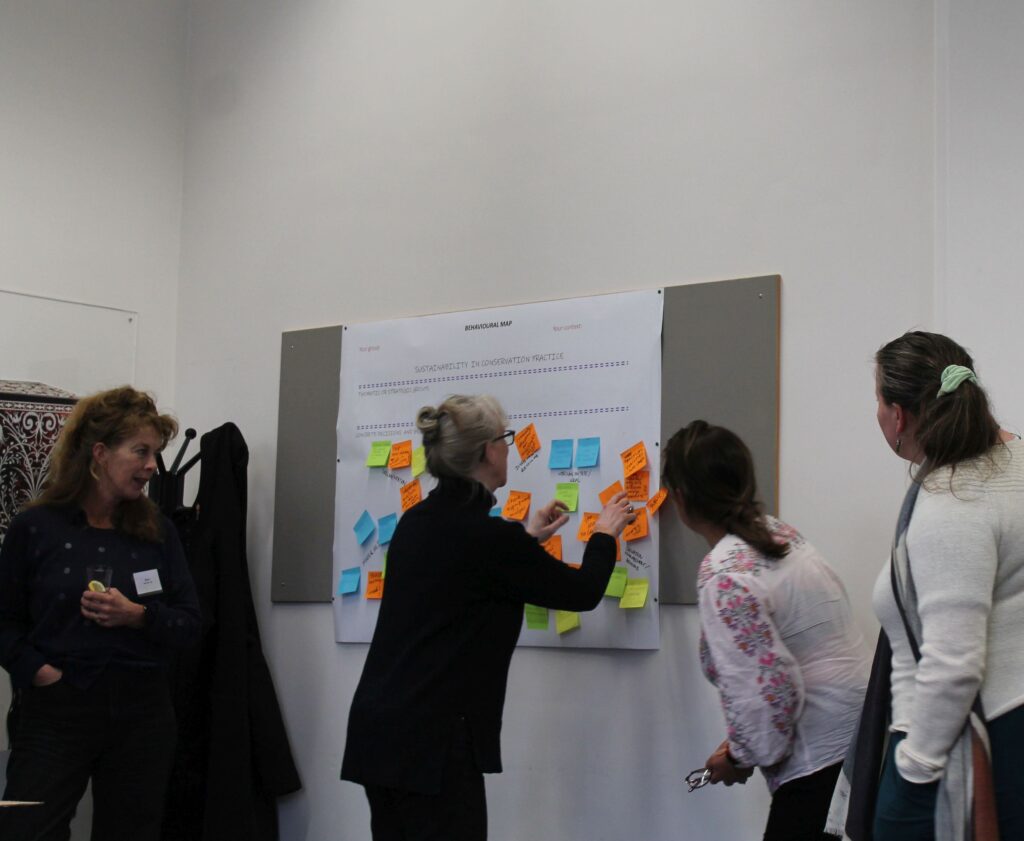
Figure 5. A workshop meeting with conservation practitioners to better understand how green conservation can be better integrated into preventive and interventive practices. The workshop was part of a co-design approach to developing a model that connects green conservation with different kinds of conservation activities.
WORK PACKAGE 3 - Green Cleaning Methods
Current Progress
The development of innovative green materials for metal and paintings cleaning: A comprehensive bibliographic study has been conducted on historical recipes and innovative green methods for cleaning paintings and metal objects. Building on this, new materials are being developed and continuously refined through an iterative process: they are produced, tested, and adjusted based on results on mock-ups and real objects. Moreover, their effectiveness is compared against benchmarks which has been defined involving the conservation community through surveys and workshops.

Figure 6. The process of developing new green solutions for metal and painting cleaning.
A new type of retentive systems for delivering the solvent/cleaning agent onto the surfaces to be treated has been developed and tested. These systems are based on nonwoven fabrics with micro/nano porosity, which allows them to retain the solvent and simultaneously remove the undesired layer through capillary action of the swollen/solubilized coating. As the characterization of these materials and their mechanism of action continues, more sustainable and functionalized versions are being explored. In parallel, in collaboration with SAATI SPA, efforts are underway to optimize industrial production.
All the details can be found in our latest publication: F. Ramacciotti et al., ‘Microporous electrospun nonwovens combined with green solvents for the selective peel-off of thin coatings from painting surfaces’, Journal of Colloid and Interface Science, vol. 663, pp. 869–879, 2024, doi: 10.1016/j.jcis.2024.03.006.

Figure 7. Scheme of the new materials produced. The nonwoven mat is coupled with greener solvents and applied on the surface to treat. After a few minutes, thanks to the capillary rise, without further treatments, the area is clean, restoring its original colour.
We are collecting and studying historical cleaning methods from various historical sources as a means of finding inspiration for greener alternatives to current conservation methods. These recipes were developed in a low-tech environment, making use of natural, bio-based materials, before highly refined chemical products dominated the material choices in modern conservation. Many of these materials are discontinued and not well-known today due to various historical factors. We hope that by improving understanding of these factors and the properties of historical materials through reconstruction experiments, we can reopen paths closed in the past and re-introduce some material choices as greener alternatives for modern use. The historical recipes also provide us with insights into a dynamic perception of cleanliness in the history, which can be different from modern expectations in a museum setting. Reflections on this changing perception of cleanliness may by itself be a step towards more sustainable practices to avoid unnecessary cleaning or over-cleaning of heritage objects.
All the details can be found in our latest publication: Zhou, H., M. Stols-Witlox, and L. Bertrand. “Be Clean, Be Green: Perception of ‘Cleanliness’ in the History and Reflection on the Cleaning Treatments of Silver in Modern Conservation Practice”. History, Culture, and Heritage, AHM Conference 2024: ‘Heritage, memory and Material Culture’, Vol 3 (2024): 61-68. DOI: https://doi.org/10.5117/9789048567638/AHM.2024.011.
The development of innovative green protocols for metal cleaning has focused on substrates of silver, copper, iron and their alloys. Combining a natural surfactant, saponin, and a deep eutectic solvent, aquoline, a new cleaning material named 'sapoline' for the removal of corrosin from copper, brass and steel was developed [1]. Regarding silver cleaning, two greener aging protocols were designed to propose highly reliable and reproducible silver mock-up systems [2,3,4]. Using the silver mock-up systems developed, amino acid-based cleaning protocols are also studies. Preliminary cleaning tests applied on various types of silver objects such as silver-plating, sterling silver and gilded silver showed promising results. Ongoing developments include the application of electrospun mats for metal cleaning.

Figure 8. (a) Schematic illustration of the aging chamber using albumin solution (AS) as a green aging reagent [4]; (b) RTI images of AS-aged sterling silver and pure silver coupons with different exposure times; (c) cleaning process of a sacrificial sterling silver spoon treated with our amino acid solution protocol; (d) a naturally tarnished gilded silver object (necklace) cleaned with various amino acid-gel protocols.
1. Wu, Q. and E. Joseph. "The application of an innovative green material 'sapoline' for the cleaning of historical metal objects". ICOMCC-Metal2025, in press.
2. Wu, Q., H. Zhou, L. Bertrand, M. Stols-Witlox, L. Brambilla and E. Joseph. "Natural and Artificial Aging Methods For Silver Mock-ups In Recent Conservation And Heritage Studies: A Short Review". Chemistry-Methods (2025) e202400055. https://doi.org/10.1002/cmtd.202400055.
3. Wu, Q., K. Gubanov, H. Zhou, I. Marozau, A. Passaretti, J. Gonzalez Frutos, C. Degrigny, L. Bertrand, M. Stols-Witlox, L. Brambilla, and E. Joseph. "Characterisation of assessment of two green aging methods for silver mock-up systems using multi- analytical techniques". The European Physical Journal Plus, in press.
4. Wu, Q., H. Zhou, J. Gonzalez Frutos, C. Digrigny, L. Bertrand, M. Stols-Witlox, L. Brambilla and E. Joseph. "Development of green aging methods for silver". InArt2024 - Volume "Innovation in Art Conservation Research" (Springer), in review.
WORK PACKAGE 4 - Green Stabilisation Technologies
Current Progress
Work package 4 aims to propose green solutions for the stabilisation (including consolidation) of heritage objects from metal and glass substrates, as alternative to the traditional environmentally unfriendly methods.
In WP4, we are developing an innovative glass stabilisation treatment using mesoporous silica nanoparticles (MSNs) functionalised with an amine group to reduce moisture interaction with the glass surface. This approach aims to mitigate the deterioration of historical glass objects by preventing salt formation, a common degradation issues. Initial deposition of functionalised MSNs via spin coating (Figure 9) has demonstrated promising results, significantly decreasing salt crystallisation on artificially aged glass mock-ups. These findings suggest that the treatment effectively enhances the stability of glass surfaces under humid conditions, making it a potential breakthrough in glass conservation.
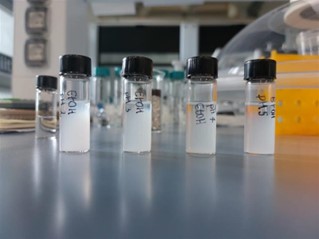
Figure 9. Functionalised mesoporous silica nanoparticles in different solutions.
The development of greener protocols for the stabilisation of archaeological iron has focused on microbiologically derived approaches. In WP4, a novel methods has been explored using the dead biomass of Meyerozyma sp., an extremophilic yeast, to both remove chloride ions and promote the transformation of reactive iron corrosion products into more stable phases. Preliminary studies have demonstrated the potential of Meyerozyma sp. biomass to biosorb harmful ions into the yeast cell wall and facilitate the conversion of akaganéite and other unstable corrosion products into magnetite or goethite [1]. This biologically based treatment offers a non-toxic and environmentally friendly alternative to conventional stabilisation techniques. Current research is focused on evaluation the effects of pH, corrosion morphology, and exposure duration on treatment efficacy. In parallel, efforts are underway to optimise the application system to ensure uniform and consistent results.
Petrasz, P., Zhioua, S., James, S., Bindschedler, S., Junier, P., & Joseph, E. (2024). Green alternatives for archaeological iron stabilization. Studies in Conservation, 69(sup1), 270-280. https://doi.org/10.1080/00393630.2024.2336880
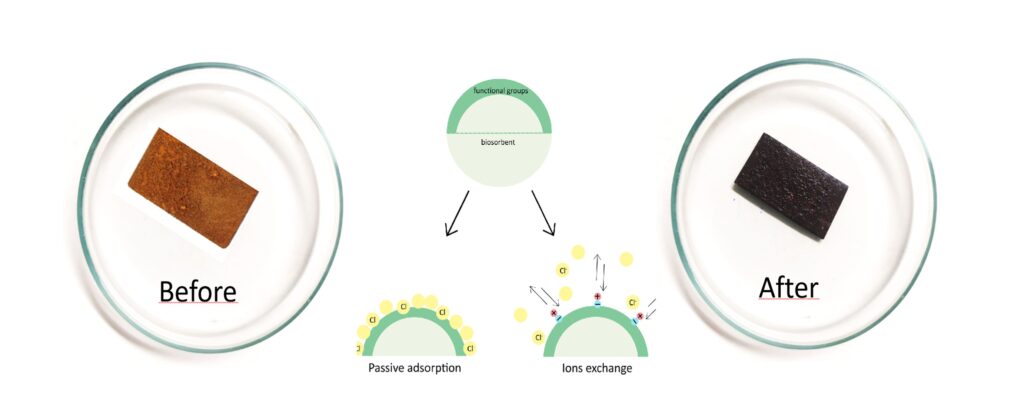
Figure 10. Artificially aged coupon before and after treatment with Meyerozyma sp. dead biomass, graph describing mechanism (in the middle).
WORK PACKAGE 5 - Methodologies for Greener Solutions
Current Progress
This work package focuses on four main actions, and it was initiated with a network-wide survey of available methods and their practical implementation for the purpose of the project, favoring cross-consortium exchanges on methods.
An AI-based tool was developed to identify and quantify cracks in historical glass caused by crizzling phenomena. The tool was optimized using artificially aged glass samples and progressively refined for almost totally efficient detection.
2D scanning imaging techniques are being developed to support various objectives of the GoGreen consortium. Notably, protocols coupling photoluminescence with FT-IR imaging, as well as hyperspectral imaging, is developed to assess cleaning and varnish removal methods developed in work package 3.
Novel 3D imaging approaches are being explored to evaluate cleaning and consolidation processes. These include the integration of X-ray Raman spectroscopy with digital techniques to generate 3D chemical images of sensitive cultural heritage samples, as well as semi-quantitative X-ray nano- and micro-tomography to assess the stabilization effects of bio-based treatments on metal artifacts.
Finally, efforts are made to develop several user-friendly methods such as laser speckle and reflectance transformation imaging for conservation studios, ensuring practical application in professional environments.
WORK PACKAGE 6 - Web App Prototyping
Current Progress
The GoGreen-Digital Support App (DSA) empowers conservators to make informed decisions by considering the environmental impact of preservation, cleaning, and conservation treatments. The app includes two main sections: one dedicated to interventive practices, and the other to preventive ones. In the Interventive section, users can utilize Comparison Calculators to assess the environmental sustainability of the materials or treatments they plan to apply. The DSA also comes with user-friendly tutorials designed to guide users through their initial experience with the app.
Additionally, the Deep Dive section introduces users to the latest advancements in green conservation practices, including the innovative solutions developed during the GoGreen project.
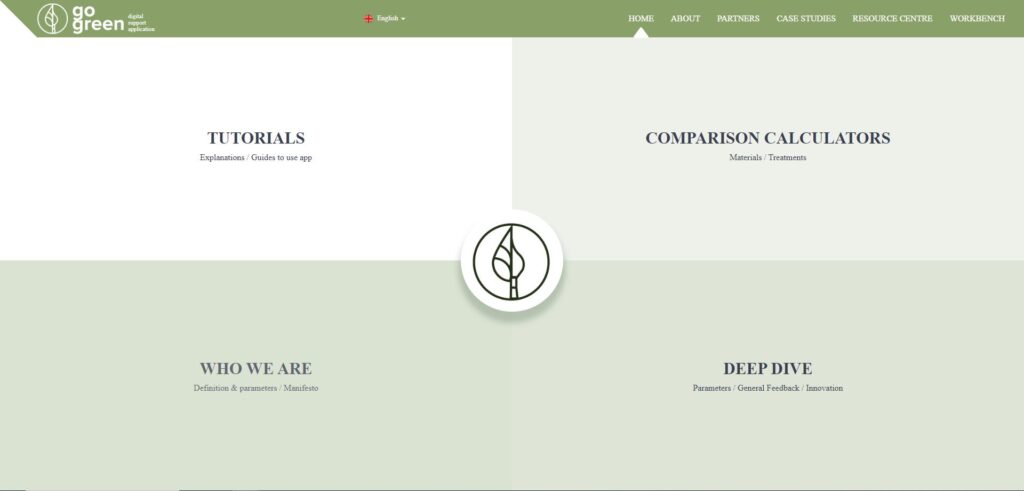
Figure 11. GoGreen-DSA layout with links to the four pages in the Interventive section.
The materials and treatments will be evaluated based on Green Parameters define within the project. These parameters are categorized according to their strategic impact:
- Hazard impacts on human health and the environment
- Impacts on climate change
- Impacts on resource consumption
- Professional considerations related to art conservation
These groupings ensure a comprehensive assessment, aligning conservation practices with sustainable and responsible standards.
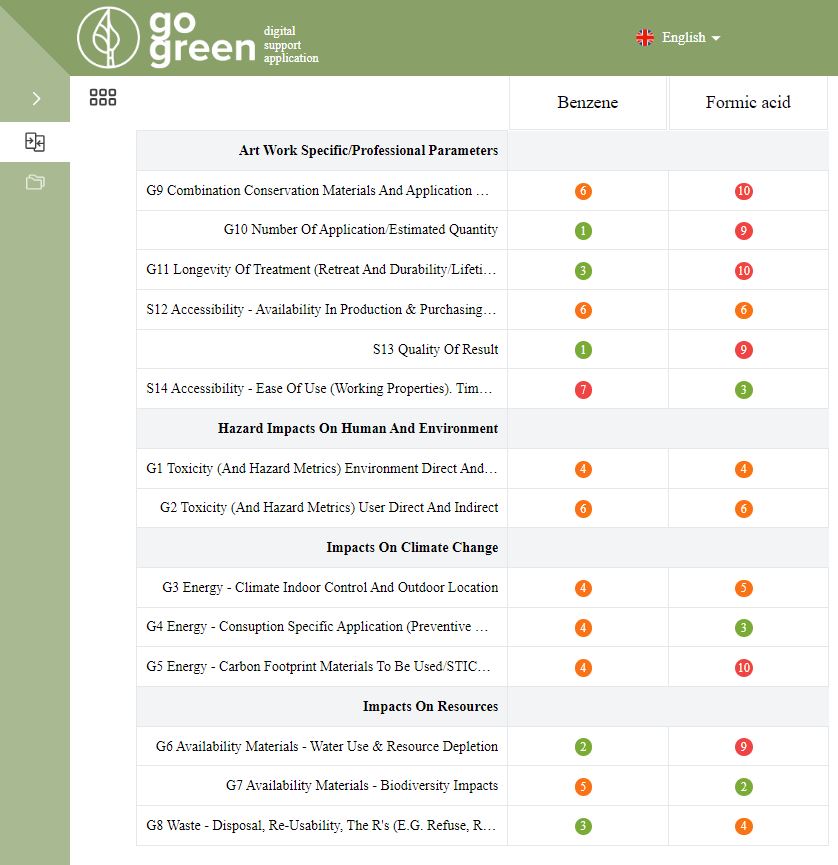
Figure 12. Comparison Calculator section of GoGreen-DSA: example of a comparison between benzene and formic acid based on green parameters.
WORK PACKAGE 7 - Green Education
Current Progress
Work package 7 focusses on Green Education and is led by the Courtauld Institute of Art. Work package 7 aims to empower conservation professionals to become leaders in sustainable heritage preservation. Through targeted education and training, this work package support both practicing and emerging conservators in integrating greener practices into their work. The research outputs of GoGreen will be translated into four flexible educational modules:

Figure 13. The four Educational Modules that will be produced through GoGreen.
These modules are being developed using a skeletal framework to ensure adaptability across different academic and professional contexts. Work package 7 is structured around two key deliverables:
7.1: Preparation of Didactic Materials
(Module templates, bibliographies, and learning resources)
To initiate module development, a symposium was held in Paris focused on innovative approaches to teaching sustainability in conservation. This event brought together conservation educators, heritage scientists, early-career researchers, and practitioners for interdisciplinary dialogue, resulting in initital outlines for the four modules.
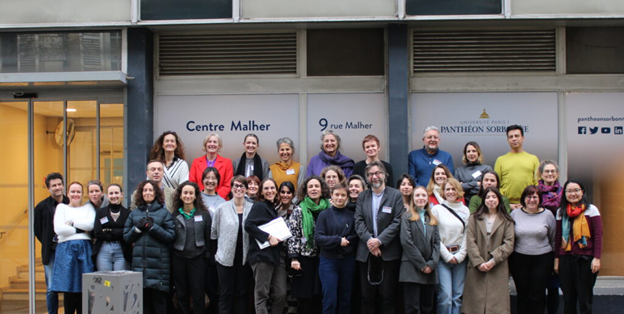
Figure 14. The GoGreen Symposium in Paris. Read more about the Paris Symposium here.
The draft modules from the symposium are now undergoing review by a dedicated focus group within the GoGreen consortium.
7.2: GoGreen Academy
As part of this deliverable, work package 7 will organise workshops for both practitioners and educators, utilising the educational modules developed in 7.1. The outputs of WP7 will be published in an open-access platform for future use.
Webinar WP7 on Green Education
The WP7 webinar was held on the 24th of April 2025 and the recording is available now! During this session, we dive into how collaboration has helped shape innovative course modules focused on green education in conservation. The webinar highlights the key outputs of work package 7 and how they will contribute to a more sustainable conservation curriculum. Lean how you can get involved in helping shape these courses to help inspire the next generation of green leaders in conservation. The full WP7 webinar can be watched on the GoGreen YouTube channel.
It is also possible to download the PowerPoint presentation given during the webinar. Click here to download the PDF file.
To stay updated on the GoGreen Academy and future module developments, be sure to subscribe to the GoGreen newsletter!
WORK PACKAGE 8 - Communication, Dissemination & Exploitation
Current Progress
Communication, Dissemination & Exploitation
All to often progress within conservation is slowed down because amazing research and developments stay in labs and academic publications. So how can we ensure that all of the amazing green solutions from GoGreen get to you - our global conservation community? Through effective communication, dissemination and exploitation!
WP8 is committed to ensuring that conservators everywhere will benefit from the amazing work being done in the project. We have developed a comprehensive communications strategy to ensure that you are informed and up to date on the work we are doing - and have access to it so you can use it in your conservation work!
Through our series of GoGreen webinars, conference appearances, publications, social media, newsletters and our website, we aim to inform and inspire. Make sure to follow along to get the latest from GoGreen!
Policy & Advocacy
GoGreen is facilitating the creation of a definition of "green" for the conservation field. By aligning on what green means, we can then ensure that we are all working toward the same goals in the same way - avoiding greenwashing and making a real difference! For information about the process of defining green and the current status, check out the Defining Green Conservation section of the website.
Defining Green
Through the GoGreen project, we want to ensure that not only is all of the information available, but that it has an impact. This is why GoGreen will be advocating with national and international membership organizations and global conservation leaders to promote green conservation and the implementation of standards and practices which support green practices. The GoGreen team will work across the sector and with relevant stakeholders. Stay tuned for endorsements and partnership announcements!
